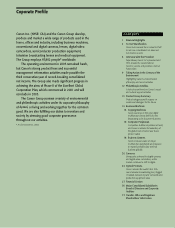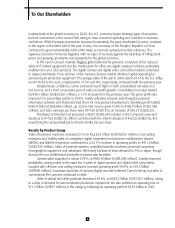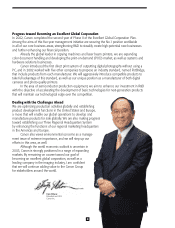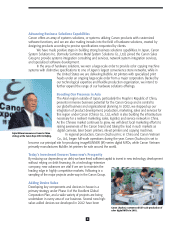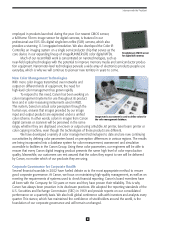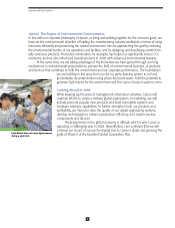Canon 2002 Annual Report Download - page 4
Download and view the complete annual report
Please find page 4 of the 2002 Canon annual report below. You can navigate through the pages in the report by either clicking on the pages listed below, or by using the keyword search tool below to find specific information within the annual report.
Looking back at the global economy in 2002, the U.S. economy began showing signs of an upturn,
but lost momentum in the second half, owing to slow consumer spending and a decline in business
confidence. While European economies recovered moderately, the pace decelerated in some countries
in the region in the latter half of the year. In Asia, the economy of the People’s Republic of China
continued to grow substantially, while other Asian economies sustained modest advances. The
Japanese economy remained stagnant, with no signs of recovery against the backdrop of falling stock
prices and growing uncertainty over prospects for the global economy.
In the Canon Group’s markets, flagging global demand for personal computers (PCs) reduced
sales of IT-related equipment, but the market grew for office-use digital copying machines, particularly
multifunction and color products. The digital camera and digital video camcorder markets continued
to expand worldwide. Price declines in the memory devices market inhibited capital spending for
semiconductor production equipment. The average value of the yen in 2002 was ¥124.73 to the U.S. dollar,
and ¥118.39 to the euro, a depreciation of 3% and 8%, respectively, compared with the previous year.
Despite these conditions, Canon achieved record highs in both consolidated net sales and
net income, and a third consecutive year of sales and profit growth. Consolidated net sales totaled
¥2,940.1 billion (US$24,501 million), a 1.1% increase from the previous year. The gross profit ratio
improved 3.6 percentage points, to 47.6%, mainly reflecting reduced costs through production
reformation activities and shortened lead times for new product development. Operating profit totaled
¥346.4 billion (US$2,886 million), up 22.9%. Net income grew 13.8% to ¥190.7 billion (US$1,589
million), and basic earnings per share were ¥217.56 (US$1.81), an increase of ¥26.27 (US$0.22).
The Board of Directors has proposed a ¥5.00 (US$0.04) increase in the Company’s year-end
dividend, to ¥17.50 (US$0.15). When combined with the interim dividend of ¥12.50 (US$0.10), this
would bring the annual dividend to ¥30.00 (US$0.25) per share.
Results by Product Group
Sales of business machines increased 0.1% to ¥2,226.2 billion (US$18,552 million). Cost-cutting
measures and healthy sales of competitive digital networked monochrome multifunction devices
(MFDs) and Bubble Jet printers contributed to a 22.7% increase in operating profits, to ¥411.0 billion
(US$3,425 million). Sales of business systems, including facsimile machines, personal computers,
micrographics equipment and calculators, fell mainly because of slow demand for PCs in Japan, though
demand for our multifunction facsimile machines was favorable.
Camera sales expanded a robust 27.4%, to ¥485.8 billion (US$4,048 million). Greatly improved
profitability, owing mainly to the rapid rise in sales of digital cameras and digital video camcorders,
coupled with effective cost-cutting measures, boosted operating profit 94.5%, to ¥70.3 billion
(US$586 million). Successive launches of compact digital cameras bolstered Canon’s lineup, but sales of
conventional film cameras continued to slide.
Sales of optical and other products decreased 24.6%, to ¥228.2 billion (US$1,901 million), owing
to a drop in demand for semiconductor production equipment. We also suffered an operating loss of
¥11.7 billion (US$97 million) in this category, following an operating profit of ¥23.9 billion in 2001.
2
To Our Shareholders


